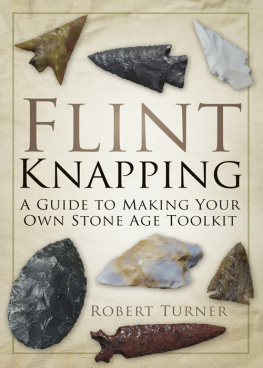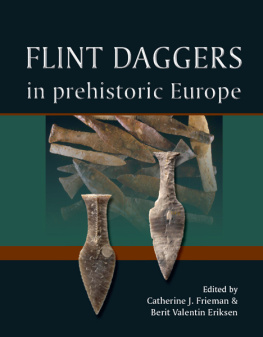To my wife, Gillian Turner, who puts up with my flint knapping, puts up with my writing and then proofreads my work for me.
C ONTENTS
CKNOWLEDGEMENTS
Especial thanks to:
James Turner, my son, for the photographs in this book; D.C. Waldorf for kind permission to reproduce the drawings of the late Val Waldorf.
My thanks to the following people for help, guidance, contribution and permissions:
Bob Wishoff; Bobby Collins; Brian Thomson; Chris Chitwood; Derek Mclean; Dick Grybush; Ed Thomas; Jack Hemphill; Jerry Marcantel; Kurt Phillips; Larry Kinsella; Mark Ford; Pat Jones; Philip Churchill.
N I NTRODUCTION TO K NAPPING
I f you have even a passing interest in archaeology then you will soon become acquainted with stone tools. At one time our ancestors made and used these implements on a daily basis to hunt, prepare food and clothing, to farm and make shelters and all the other tasks required for Stone Age existence.
In many parts of the world the most readily available material was flint or chert, which is SiO2 or silicon dioxide, which is why this art is commonly called flint knapping. Even in igneous rich parts of the world where obsidian, or volcanic glass, is readily available, this terminology can persist.
One of the properties of silicon is that it will carry a shock wave that allows a splitting of the material to be directed along a chosen plane. When you hit a piece of flint, a shock wave travels through the material that causes a fracture along the line of wave. If the impact is sufficiently powerful, this will follow a fairly straight line and parallel the contour of ridges already in the rock. In this way early knappers learned that they could direct the splitting of the rock to achieve a desired shape for severing, cutting and piercing tools.
Flint and chert are what is termed cryptocrystalline, meaning that there is no grain or sheer planes in the rock. The material is sedimentary and was formed in chalk and limestone when these beds were first laid down. Flint which was formed in chalk is varied in colour from white through shades of grey to black, but sometimes it can take on a brown or reddish hue, especially if contaminated by iron. Chert, which is usually a product of limestone, can be a far greater range of colours again dependent on the impurities it acquires. Some of the very best flint can be almost translucent but the rest of the material group is predominantly opaque.
Obsidian, which is a metamorphic rock formed in volcanic action, can also take on a range of colours. Unfortunately, there is no quality, knappable Obsidian found in Britain, but many other parts of the world, especially the USA, have a range of rhyolites that can take on beautiful banded and coloured forms, which make knapping a wonderful art form.
Many people want to have a go at knapping but because they are unable to know how to start, attempts are usually a disappointing failure. The image of Stone Age man making and using stone tools is one we are all familiar with and as they were our ancestors, there is always a certain amount of attachment to those far-off days. Flint, however, is still all around us, in cigarette lighters and gas and barbeque lighters, all of which carry that small bit of the material. In certain parts of the country flint is a major building material and many of our beaches have shingle, which is just flint by another name.
Go back a hundred and a bit years and gun flints were used all over the world, most of them made in Britain. The gun flint industry was vast and in one year alone, just before the Crimean War, Turkey ordered 11,000,000 flints of various sizes from Britain. Millions were sold to the American and African markets and over a five-year period to 1885 one manufacturer alone, R.J. Snare and Co., produced 23,165,200 gun flints. It is not recorded who counted them but suffice it to say that flint is a material that has been with us since earliest times and still plays a part in our lives today.
Knapping has been carried out for millions of years from the first Hominids through Homo Erectus, Homo Heidelbergensis, and Neanderthals to Homo Sapiens or modern man. In Britain, we date flint tools back almost a million years as people came and went between ice ages. Our modern period started some 10,000 to 12,000 years ago following the end of the Devensian Ice Age and flint tool finds are in profusion, ranging from the Upper Palaeolithic through the Mesolithic, Neolithic and Bronze Age. Especially in the South of England on any fieldwalk you will be able to find worked flint of one sort or another, where flint is common. There is no evidence, currently, of a flint technology in the Iron Age. They may still have used flint tools, we just do not know.
So what are we trying to achieve in these pages? An understanding of how flint was used, the tools that were made and what they were made for, how to make the tools, and detailed instruction of how, with practice, you can replicate the toolkit of your ancestors.
Before we go further, I must make time for the dreaded Health and Safety rules which are totally necessary in knapping. Firstly, flint is sharper than steel and cuts, I am afraid, are a common occurrence. Gloves, or a single glove, are a good idea but thin leather like a golfing glove is far better than the traditional thick gardening type that can inhibit your knapping.
The most important item is eye protection and any form of glasses is a necessity. Your local DIY store will sell a cheap plastic pair of glasses for a few pounds and the outlay is well worth it. Flying bits of flint are rare but do not take the chance. Likewise, when you knap you quickly collect a small pile of shards on the ground around your feet, so do wear suitable shoes. A flint shard will go straight through a thin sole if stepped upon.
Robert Turner, 2013
1
T he answer to the question what can I knap? is very simple, it depends where you live. You need to gain some information of the local geology to ascertain if anything around you will be suitable for knapping and the local reference library will provide all you need. Even if you live in an area that is poor in knapping quality rock, your house still has many things that you can practise on.
The easiest things to use are the bottom of a glass bottle, reasonable thick sheet glass (window glass is too thin) and many ceramic materials. The old kitchen sinks that you find in the scrapyards will work quite well, insulators from electric wire carriers and glass and ceramic tiles from your nearest DIY shop can also work. Some of the rocks sold for tropical fish tanks, especially chalcedony (pale blue rock), will knap and all glass-like materials are worth trying.
If you are lucky enough to live in a chalk or limestone area, flint and chert are for the picking up, but many other materials will knap. All you do is get a small sample and fracture it to see if it will take a conchoidal fracture.
Firstly then, we need to understand what a conchoidal fracture is and what it looks like. If you have ever chipped a glass you will have made a conchoidal fracture, as it will have made a small, almost circular or elliptical scar on the glass edge. The word comes from the Greek meaning shell and radiates out from the point of impact in ripples, looking very much like a mussel shell.

A conchoidal flake.
What you are seeing is the scar of the shock wave which has a pronounced first wave, called the bulb of percussion, and then a series of smaller waves as the shock progressed through the material. If the rock just breaks with a flat surface, this will not be suitable for knapping, so if you are buying, never invest in a quantity of any material until you have firstly tried it out.
Next page















